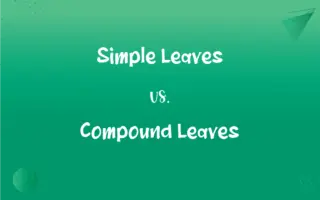Antiseptic vs. Disinfectant: What's the Difference?
Edited by Aimie Carlson || By Harlon Moss || Updated on October 9, 2023
Antiseptics are agents applied to living tissue to inhibit microorganisms, while disinfectants are substances used on inanimate objects to kill pathogens.

Key Differences
Antiseptics are specifically formulated to be safe for application on living tissues, such as skin or mucous membranes. Disinfectants, in contrast, are designed for use on surfaces and can be harmful if applied to the body.
The primary goal of an antiseptic is to reduce the possibility of infection, while the objective of a disinfectant is to eliminate harmful pathogens from surfaces.
Common examples of antiseptics include hydrogen peroxide and iodine, which can be used on minor cuts or abrasions. Disinfectants, such as bleach or ammonia, are frequently found in household cleaning products.
While both antiseptics and disinfectants aim to mitigate the risks posed by harmful microorganisms, their application and composition vary greatly. It's crucial to use each for their intended purpose.
Antiseptics often come in solutions, creams, or gels suitable for direct skin application. Disinfectants are typically in sprays or wipes intended for cleaning surfaces.
ADVERTISEMENT
Comparison Chart
Intended Use
Living tissues (skin, mucous membranes)
Inanimate objects and surfaces
Primary Goal
Inhibit or reduce microorganisms to prevent infection
Kill or eliminate pathogens
Common Forms
Solutions, creams, gels
Sprays, wipes, solutions
Examples
Hydrogen peroxide, iodine
Bleach, ammonia
Safety for Human Skin
Generally safe for skin application
Typically harmful if applied to skin
ADVERTISEMENT
Antiseptic and Disinfectant Definitions
Antiseptic
An agent that inhibits the growth of microorganisms on living tissue.
Before the injection, the nurse applied an antiseptic to the patient's skin.
Disinfectant
A substance used to eliminate pathogens from inanimate surfaces.
She cleaned the kitchen counter with a strong disinfectant.
Antiseptic
A substance used to prevent infection in wounds.
She put antiseptic on her scraped knee.
Disinfectant
A substance specifically formulated for cleaning and sanitizing non-living surfaces.
Using a disinfectant regularly can help reduce the spread of illnesses.
Antiseptic
A chemical solution that reduces microbial presence on living surfaces.
After the minor surgery, an antiseptic was used to clean the area.
Disinfectant
A product intended to exterminate germs on inanimate objects.
During the flu season, it's wise to use a disinfectant on frequently-touched surfaces.
Antiseptic
An agent that destroys or inhibits harmful microorganisms without harming living tissue.
Hand sanitizers often contain antiseptic properties.
Disinfectant
An agent that destroys harmful bacteria, viruses, and other microorganisms.
To combat the virus, they sprayed a disinfectant in public areas.
Antiseptic
A product designed for application on skin to reduce the risk of infection.
Always have an antiseptic ready in your first aid kit.
Disinfectant
A chemical agent that kills or inhibits the growth of harmful organisms on objects.
Hospitals use disinfectants to maintain sterile environments.
Antiseptic
Capable of preventing infection by inhibiting the growth of infectious agents.
Disinfectant
An agent, such as heat, radiation, or a chemical, that is applied to inanimate objects to destroy, neutralize, or inhibit the growth of disease-carrying microorganisms.
Disinfectant
Serving to disinfect.
Disinfectant
Serving to kill germs or viruses.
I washed repeatedly with a disinfectant soap but I still caught the flu.
FAQs
Can disinfectants be applied to the skin?
Typically, no. Disinfectants are meant for inanimate objects and can be harmful to the skin.
Do disinfectants kill all types of pathogens?
While effective against many, some disinfectants may not eliminate all pathogens. It's essential to check product specifics.
What is the main use of antiseptics?
Antiseptics are used on living tissues to inhibit or reduce microorganisms and prevent infections.
Are all antiseptics safe for open wounds?
While many antiseptics are formulated for wounds, it's crucial to ensure they are intended for such use.
Are there natural antiseptics?
Yes, substances like honey and certain essential oils have antiseptic properties.
Why shouldn't disinfectants be ingested?
Disinfectants contain chemicals harmful if ingested and can cause serious health issues.
Can vinegar be used as a disinfectant?
While vinegar has some disinfecting properties, it isn't as effective as many commercial disinfectants.
What's more potent, a disinfectant or sanitizer?
Disinfectants usually have a broader and more potent germ-killing capacity than sanitizers.
Can antiseptics be used to treat fungal infections?
Some antiseptics can inhibit fungal growth, but specific antifungal treatments are generally more effective.
Are there eco-friendly disinfectants?
Yes, several eco-friendly disinfectants use natural ingredients to kill pathogens without harming the environment.
Are disinfectants safe around pets?
Not all disinfectants are pet-safe. Always read labels and keep away from pets if uncertain.
Can using disinfectants lead to resistant bacteria?
Overuse or incorrect use of disinfectants can potentially lead to resistant strains. It's crucial to use them as directed.
Can antiseptics expire?
Yes, like all products, antiseptics can expire. Always check the expiration date.
Why are there different types of disinfectants?
Different disinfectants target different pathogens and are suitable for various surfaces and environments.
Can I use an antiseptic as a surface cleaner?
While antiseptics can inhibit microorganisms, disinfectants are generally more effective for cleaning surfaces.
Should antiseptics be diluted before use?
Some might require dilution. Always follow the product's instructions.
Is alcohol an antiseptic?
Yes, alcohol can act as an antiseptic, often found in hand sanitizers and wound cleansers.
Are there any side effects to using antiseptics?
Some people might experience skin irritation or allergic reactions. Always test a small area first.
Is there a difference between antiseptic soap and regular soap?
Yes, antiseptic soap contains agents specifically to inhibit microorganisms, while regular soap focuses on cleaning.
How often should high-touch surfaces be cleaned with disinfectants?
Regularly, especially during illness outbreaks. However, frequency depends on the specific environment and use.
About Author
Written by
Harlon MossHarlon is a seasoned quality moderator and accomplished content writer for Difference Wiki. An alumnus of the prestigious University of California, he earned his degree in Computer Science. Leveraging his academic background, Harlon brings a meticulous and informed perspective to his work, ensuring content accuracy and excellence.
Edited by
Aimie CarlsonAimie Carlson, holding a master's degree in English literature, is a fervent English language enthusiast. She lends her writing talents to Difference Wiki, a prominent website that specializes in comparisons, offering readers insightful analyses that both captivate and inform.































































